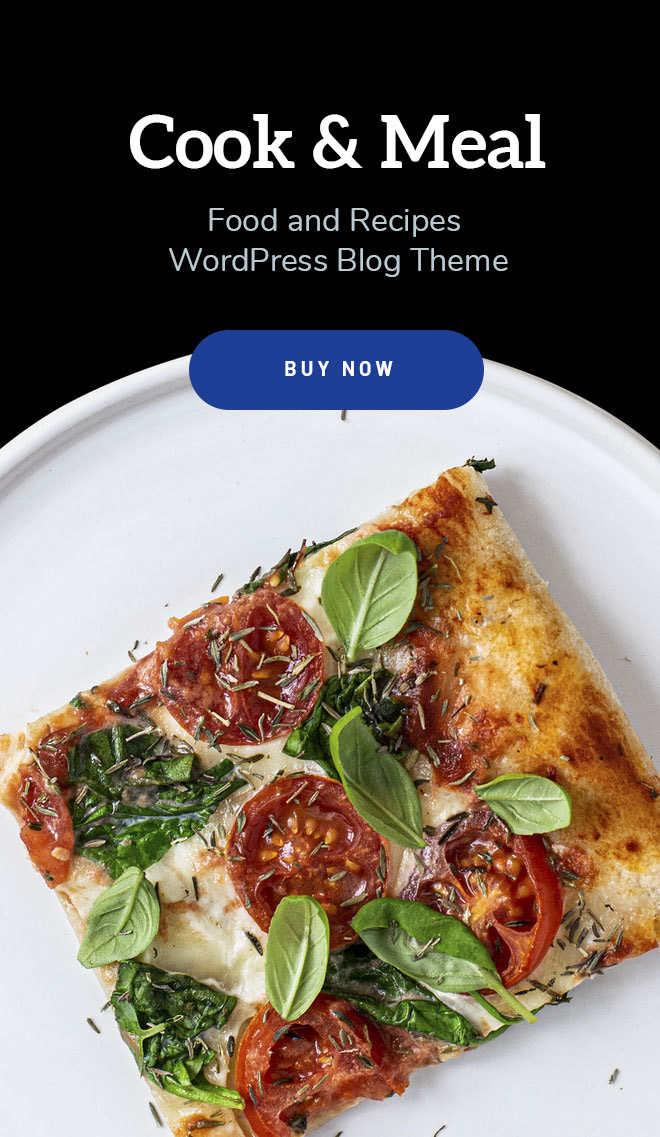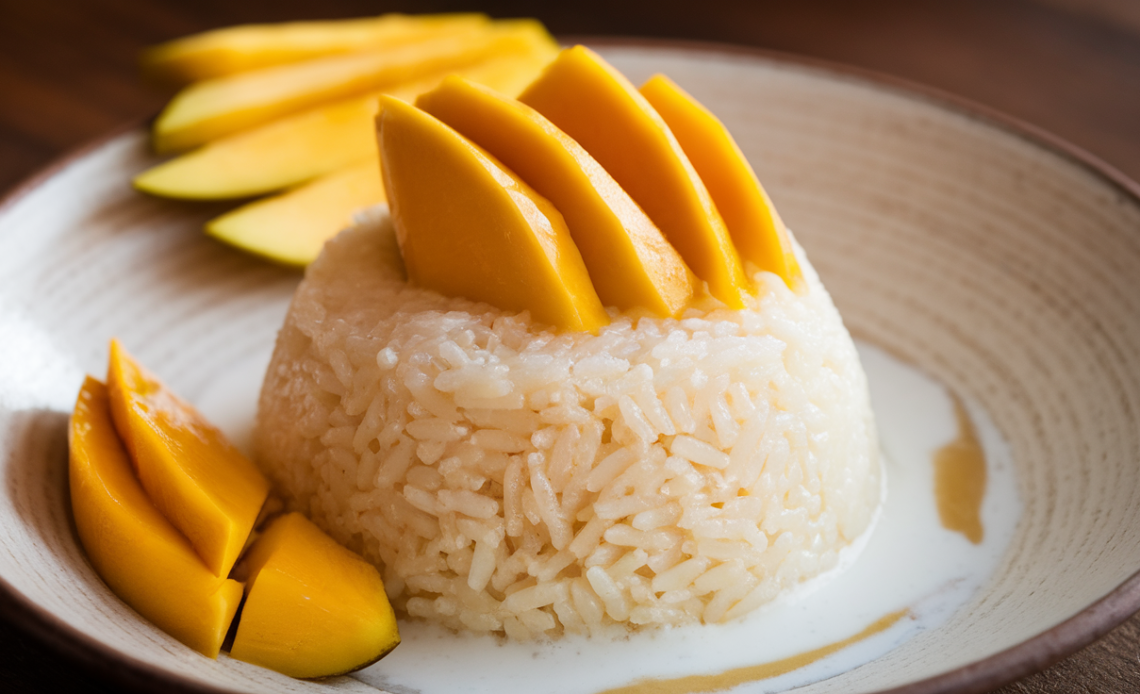
Thai Mango Sticky Rice, also known as Khao Niew Mamuang, is a beloved dessert from Thailand that has gained global popularity for its sweet, creamy, and satisfying flavor combination. This traditional Thai rice and mango dessert is made with glutinous rice, fresh mango, and a coconut milk-based sauce. It’s a simple yet indulgent treat that combines textures and flavors in a delightful way, making it a perfect dessert for any occasion.
In this article, we will explore how to make Sweet Sticky Rice with Mango, the ingredients you’ll need, step-by-step instructions, tips for perfecting the dish, and ideas for variations on this Thai sweet sticky rice coconut milk dessert. Whether you are a fan of mango with sticky rice or you are trying this dessert for the first time, you’ll find this recipe easy to follow and absolutely delicious.
Ingredients for Thai Mango Sticky Rice
The main ingredients for Thai sweet rice and mango are simple and can be found at most grocery stores or Asian markets. For the best results, it’s essential to use the right kind of rice and coconut milk. Here’s what you will need:
- 1 cup glutinous rice (also called sticky rice or sweet rice) – This type of rice has a unique sticky texture when cooked and is essential for the Thai coconut sticky rice part of the dish.
- 1 1/4 cup coconut milk – Use full-fat coconut milk for a rich and creamy texture. It will be mixed with sugar and salt to create the coconut sauce for the sticky rice.
- 1/2 cup sugar – You can use white sugar, palm sugar, or a combination for an authentic flavor.
- 1/4 teaspoon salt – This enhances the sweetness of the coconut milk and adds balance to the flavors.
- 2 ripe mangoes – Make sure the mangoes are sweet and ripe for the best flavor. The mango should be peeled, pitted, and sliced thinly for serving.
Optional ingredients:
- Sesame seeds or mung beans – For garnish, adding texture and flavor.
- Banana leaves – This is an optional presentation method, used to wrap and serve the sticky rice for a more authentic look.
How to Make Thai Mango Sticky Rice
Making Sticky Rice Meal Ideas like this requires a few essential steps. You’ll be cooking the rice first, then preparing the coconut sauce, and finally combining the two with the sliced mango. Here is a step-by-step guide on how to prepare this delicious Mango and Sticky Rice Recipe:
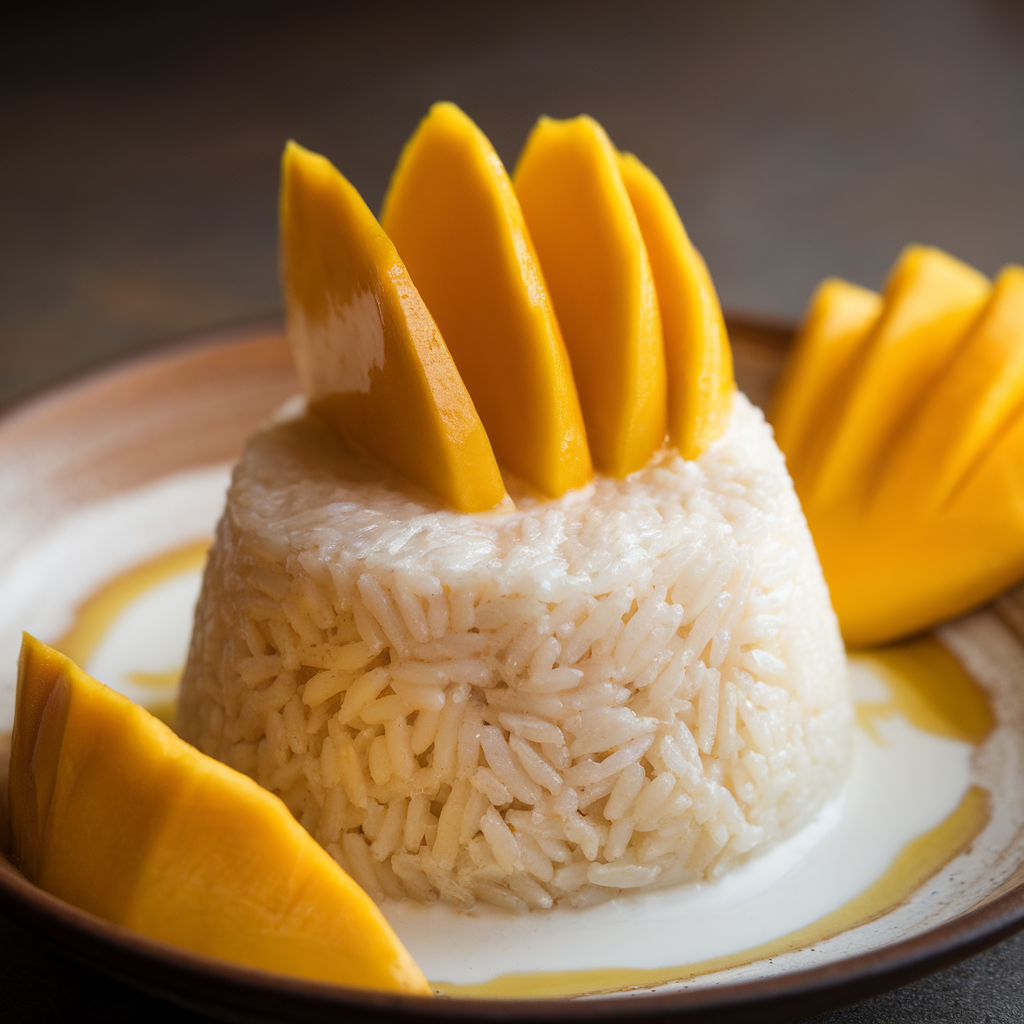
Step 1: Rinse and Soak the Glutinous Rice
The first step in making Thai Mango Sticky Rice is to rinse the glutinous rice. It’s essential to wash the rice well to remove excess starch, which ensures the rice turns out sticky and not overly clumpy. To do this:
- Place the rice in a fine-mesh sieve or a large bowl.
- Rinse the rice under cold water until the water runs clear.
- After rinsing, soak the rice in water for at least 1 hour or up to 4 hours. Soaking the rice helps it cook evenly and achieve the desired sticky texture.
Step 2: Steam the Glutinous Rice
While the rice is soaking, prepare a steaming setup. You can use a bamboo steamer or a fine mesh sieve placed over a pot of boiling water. If using a bamboo steamer, line it with cheesecloth to prevent the rice from falling through.
- Once the rice has soaked, drain it and place it into the steamer basket.
- Steam the rice over medium heat for about 20-30 minutes, or until it becomes soft and sticky. You can check for doneness by tasting a small portion of the rice – it should be tender yet firm and sticky.
Step 3: Prepare the Coconut Sauce
While the rice is steaming, prepare the coconut sauce, which is the key to making Thai Mango Dessert taste so deliciously creamy and sweet. In a saucepan:
- Combine the coconut milk, sugar, and salt.
- Heat the mixture over medium heat and stir until the sugar dissolves and the sauce becomes warm. Do not let it boil, as this can cause the coconut milk to separate.
- Once the coconut sauce is ready, remove it from the heat and set it aside.
Step 4: Combine Rice and Coconut Sauce
Once the rice is cooked and the coconut sauce is ready, combine the two. Transfer the cooked sticky rice to a large bowl or a dish and gently pour the coconut sauce over it. Stir well to ensure the rice absorbs all the coconut milk, making the rice soft and flavorful. Let it sit for 15-20 minutes, allowing the coconut milk to soak into the rice.
Step 5: Serve the Mango Sticky Rice
To serve, divide the coconut sticky rice into individual portions. Arrange the thinly sliced ripe mango on top or beside the sticky rice. For added texture and flavor, you can sprinkle sesame seeds or mung beans on top for a little crunch. If you want an authentic presentation, you can serve the dish wrapped in banana leaves, which will give it a beautiful and traditional look.
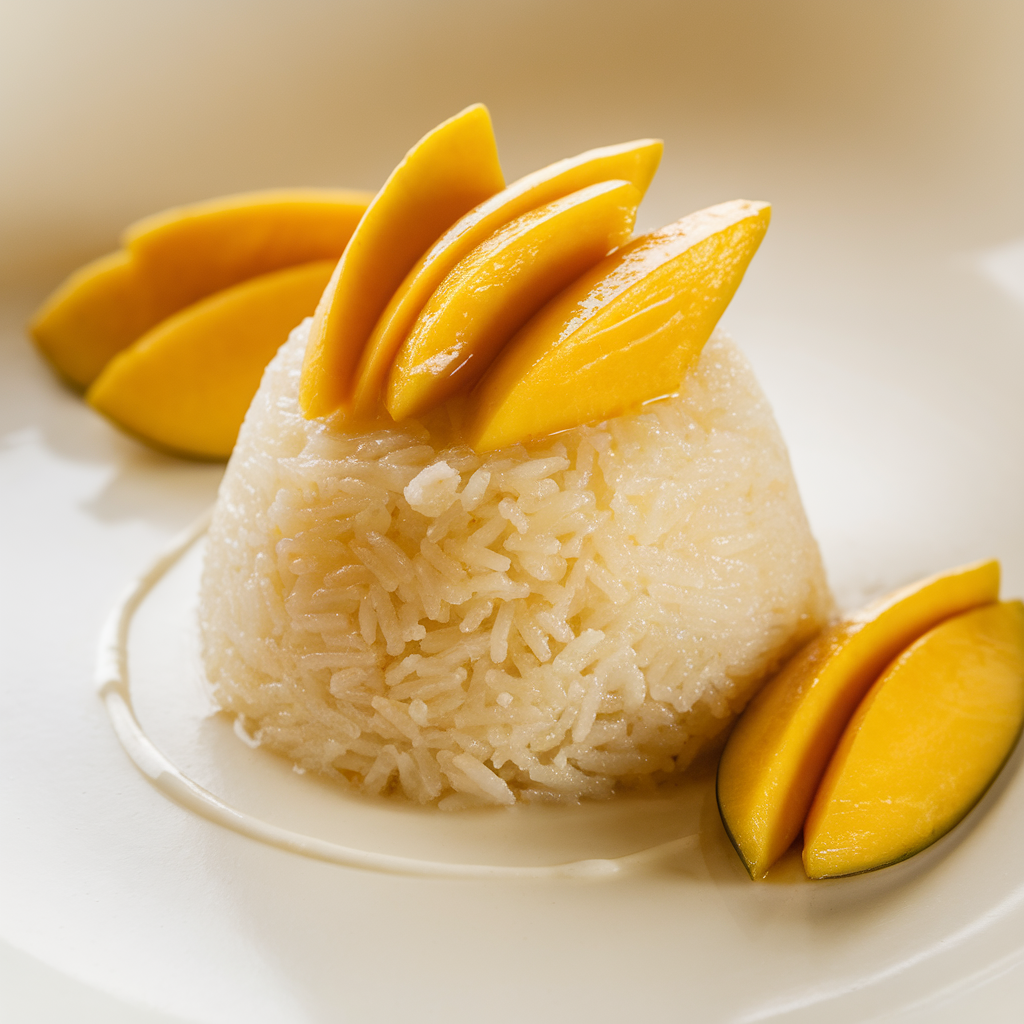
Tips for Making Perfect Thai Mango Sticky Rice
- Use the right type of rice: Always use glutinous rice (sticky rice), as regular rice will not provide the same texture. The rice is what makes this dish so unique.
- Don’t skip the soaking step: Soaking the rice is essential for making it sticky and tender. Soaking also ensures that the rice cooks evenly.
- Use full-fat coconut milk: For the best flavor and creaminess, always use full-fat coconut milk in this recipe.
- Choose ripe mangoes: Mangoes are the star of this dessert, so make sure they are ripe and sweet. Avoid using under-ripe or overly firm mangoes, as they will not provide the right flavor or texture.
- Customize the sweetness: Adjust the amount of sugar to your taste. If you prefer a less sweet dish, reduce the sugar in the coconut sauce.
Variations of Thai Mango Sticky Rice
- Add toppings or garnishes: Many people like to add sesame seeds, mung beans, or crushed peanuts as a garnish for added texture and crunch. These can enhance the flavor and give your Thai Mango Dessert a more complex taste.
- Infused coconut milk: For an extra touch of flavor, you can infuse the coconut milk with pandan leaves or a bit of vanilla extract for a subtle aromatic touch.
- Use different fruits: While mango is the most common fruit used in this dessert, you can experiment with other tropical fruits like papaya or dragon fruit to create your own variation of mango with sticky rice.
- Thai Coconut Sticky Rice with additional flavorings: You can add flavors to the sticky rice by mixing in a bit of lime zest or pandan leaves while steaming the rice, adding a unique twist to the flavor profile.
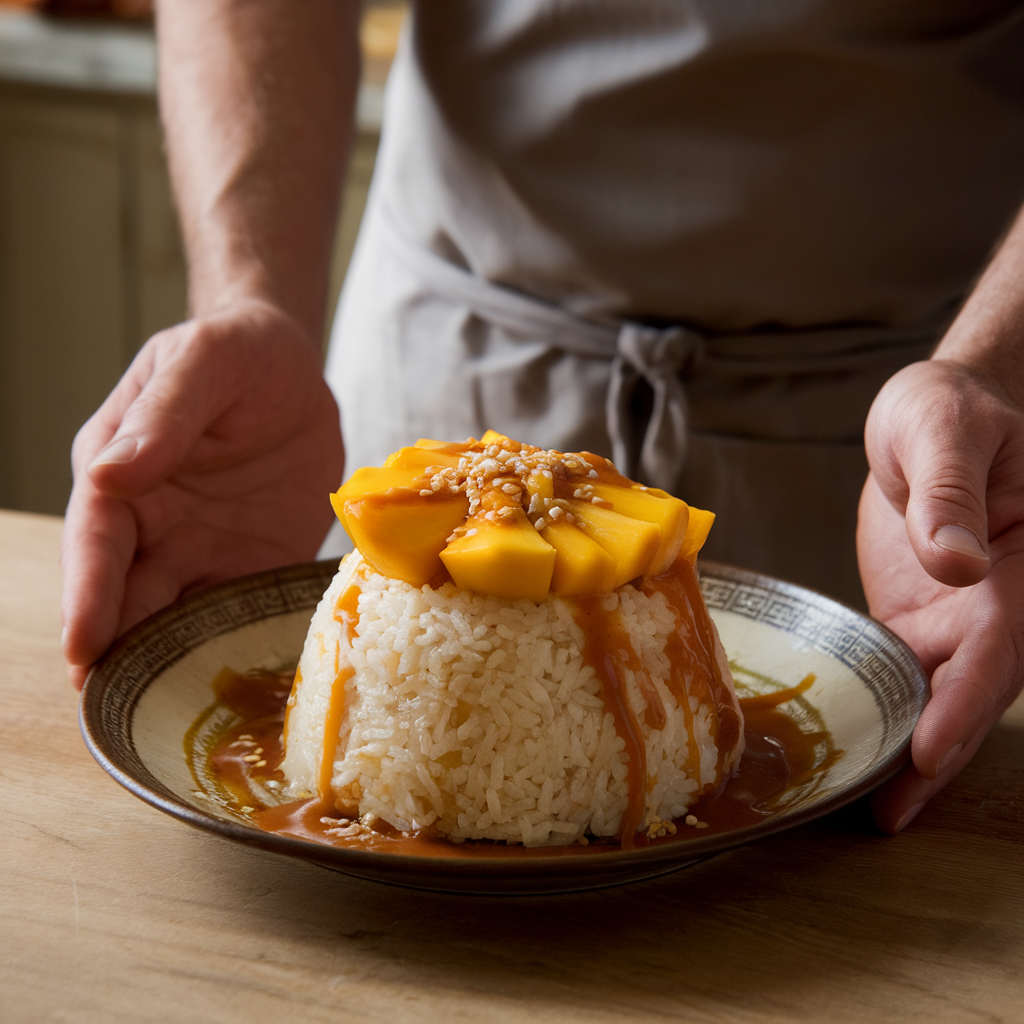
Why Thai Mango Sticky Rice is a Perfect Dessert
The Mango And Sticky Rice Recipe stands out as an exceptional dessert because it offers a unique blend of flavors and textures. The creamy, slightly salty coconut sauce pairs perfectly with the natural sweetness of the ripe mango and the chewy, sticky rice. This dessert also satisfies the craving for both sweet and savory flavors, thanks to the perfect balance of coconut milk and sugar. Plus, it’s easy to make with just a few ingredients, making it a perfect sticky rice meal idea for a quick yet indulgent treat.
Final Thoughts on Thai Mango Sticky Rice
In conclusion, Thai Mango Sticky Rice (Khao Niew Mamuang) is a classic and irresistible dessert that combines the sweetness of ripe mango with the richness of Thai sweet sticky rice coconut milk. Whether you’re looking to indulge in a Thai coconut sticky rice dish or try a new rice and mango dessert, this recipe is a must-try for anyone who loves traditional Thai cuisine. It’s an ideal dessert for warm weather or as a sweet treat to finish off a meal. With its simple ingredients and delicious taste, this Mango with Sticky Rice is sure to become a favorite in your home.




